初一英语语法易错题
《易错题》初一上英语常用语法知识——动词时态经典测试题(培优练)
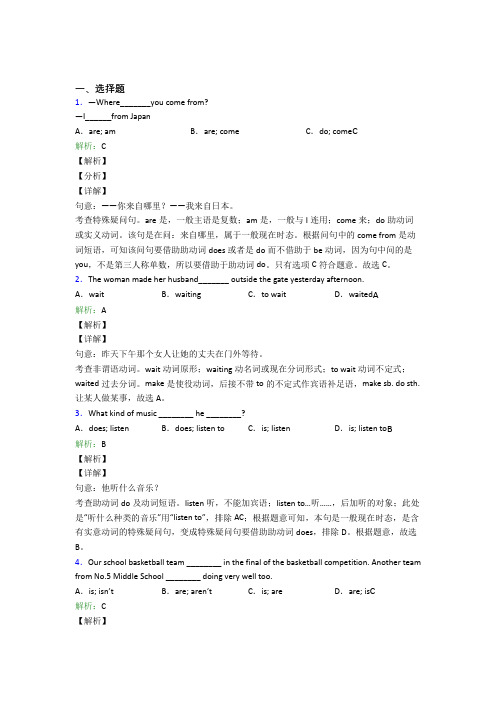
一、选择题1.—Where_______you come from?—I______from JapanA.are; am B.are; come C.do; come C解析:C【解析】【分析】【详解】句意:——你来自哪里?——我来自日本。
考查特殊疑问句。
are是,一般主语是复数;am是,一般与I连用;come来;do助动词或实义动词。
该句是在问:来自哪里,属于一般现在时态。
根据问句中的come from是动词短语,可知该问句要借助助动词does或者是do而不借助于be动词,因为句中问的是you,不是第三人称单数,所以要借助于助动词do。
只有选项C符合题意。
故选C。
2.The woman made her husband_______ outside the gate yesterday afternoon.A.wait B.waiting C.to wait D.waited A解析:A【解析】【详解】句意:昨天下午那个女人让她的丈夫在门外等待。
考查非谓语动词。
wait动词原形;waiting动名词或现在分词形式;to wait动词不定式;waited过去分词。
make是使役动词,后接不带to的不定式作宾语补足语,make sb. do sth.让某人做某事,故选A。
3.What kind of music ________ he ________?A.does; listen B.does; listen to C.is; listen D.is; listen to B解析:B【解析】【详解】句意:他听什么音乐?考查助动词do及动词短语。
listen听,不能加宾语;listen to…听……,后加听的对象;此处是“听什么种类的音乐”用“listen to”,排除AC;根据题意可知,本句是一般现在时态,是含有实意动词的特殊疑问句,变成特殊疑问句要借助助动词does,排除D。
根据题意,故选B。
《易错题》初中七年级英语常用语法知识——动词经典题(培优练)
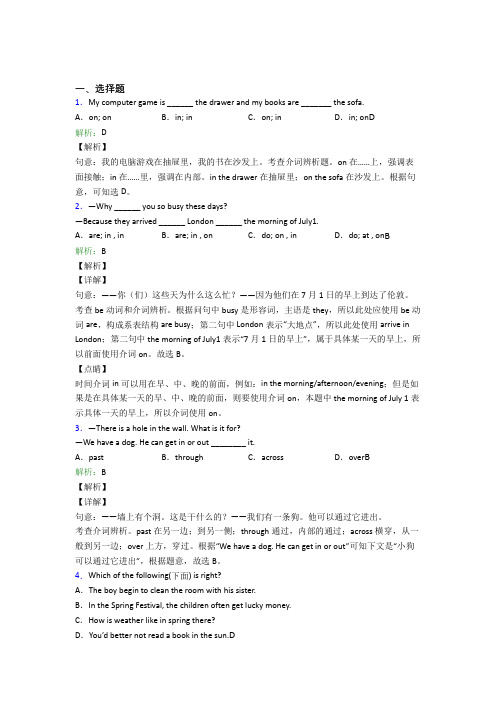
一、选择题1.My computer game is ______ the drawer and my books are _______ the sofa.A.on; on B.in; in C.on; in D.in; on D解析:D【解析】句意:我的电脑游戏在抽屉里,我的书在沙发上。
考查介词辨析题。
on在……上,强调表面接触;in在……里,强调在内部。
in the drawer在抽屉里;on the sofa在沙发上。
根据句意,可知选D。
2.—Why ______ you so busy these days?—Because they arrived ______ London ______ the morning of July1.A.are; in , in B.are; in , on C.do; on , in D.do; at , on B解析:B【解析】【详解】句意:——你(们)这些天为什么这么忙?——因为他们在7月1日的早上到达了伦敦。
考查be动词和介词辨析。
根据问句中busy是形容词,主语是they,所以此处应使用be动词are,构成系表结构are busy;第二句中London表示“大地点”,所以此处使用arrive in London;第二句中the morning of July1表示“7月1日的早上”,属于具体某一天的早上,所以前面使用介词on。
故选B。
【点睛】时间介词in可以用在早、中、晚的前面,例如:in the morning/afternoon/evening;但是如果是在具体某一天的早、中、晚的前面,则要使用介词on,本题中the morning of July 1表示具体一天的早上,所以介词使用on。
3.—There is a hole in the wall. What is it for?—We have a dog. He can get in or out ________ it.A.past B.through C.across D.over B解析:B【解析】【详解】句意:——墙上有个洞。
初中英语七年级语法填空易错题精选

初中英语七年级语法填空易错题精选一、七年级语法填空专项目练习(含答案解析)1.No pains, no gains. Without ________ (work) hard, no one can achieve success in life. 【答案】 working【解析】【分析】句意:没有付出就没有回报。
不努力工作,没有人能够在生活中取得成功。
without是介词,介词之后的动词应使用动名词,work的动名词是working。
故答案是working。
【点评】考查词形变化,根据句子结构和语境确定横线处的意思,然后根据所提供的词进行变形,最后形成答案。
2.阅读下面短文,按照句子结构的语法性和上下文连贯的要求,在空格处填入一个适当的词或使用括号中词语的正确形式填空。
Hi! My name is Jenny Brown. I________(be) a girl. Jenny is my________(one) name. My phone number is 135-0011. I am very happy with my parents. My father is John Brown and my________(mother) name is Linda. I have a________.His name is Mike Brown. I have two________(sister).________(they)names are Sally and Jane. They are________NO. 3 Middle School. I have________uncle. Gina is his________. So Gina is my cousin. I like________(she) very much.【答案】 am;first;mother's;brother;sisters;Their;in;an;daughter;her【解析】【分析】文章大意:本文作者Jenny Brown介绍自己和家人的情况。
(易错题精选)初中英语语法知识—名词的经典测试题附答案
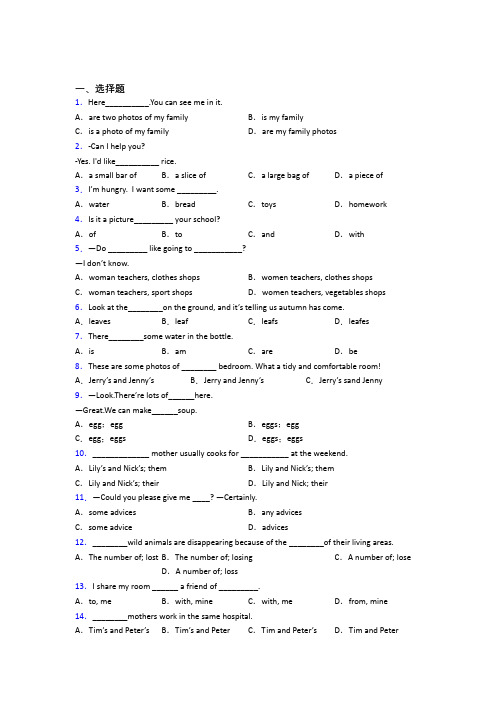
一、选择题1.Here__________.You can see me in it.A.are two photos of my family B.is my familyC.is a photo of my family D.are my family photos2.-Can I help you?-Yes. I'd like__________ rice.A.a small bar of B.a slice of C.a large bag of D.a piece of 3.I’m hungry. I want some _________.A.water B.bread C.toys D.homework 4.Is it a picture_________ your school?A.of B.to C.and D.with5.—Do _________ like going to ___________?—I don’t know.A.woman teachers, clothes shops B.women teachers, clothes shops C.woman teachers, sport shops D.women teachers, vegetables shops 6.Look at the________on the ground, and it’s telling us autumn has come.A.leaves B.leaf C.leafs D.leafes 7.There________some water in the bottle.A.is B.am C.are D.be8.These are some photos of ________ bedroom. What a tidy and comfortable room! A.Jerry’s and Jenny’s B.Jerry and Jenny’s C.Jerry’s sand Jenny 9.—Look.There’re lots of______here.—Great.We can make______soup.A.egg;egg B.eggs;eggC.egg;eggs D.eggs;eggs10._____________ mother usually cooks for ___________ at the weekend.A.Lily’s and Nick’s; them B.Lily and Nick’s; themC.Lily and Nick’s; their D.Lily and Nick; their11.—Could you please give me ____? —Certainly.A.some advices B.any advicesC.some advice D.advices12.________wild animals are disappearing because of the ________of their living areas. A.The number of; lost B.The number of; losing C.A number of; loseD.A number of; loss13.I share my room ______ a friend of _________.A.to, me B.with, mine C.with, me D.from, mine 14.________mothers work in the same hospital.A.Tim’s and Peter’s B.Tim’s and Peter C.Tim and Peter’s D.Tim and Peter15.— Is this room yours? —No, it's not__________.It's __________.A.mine; Lily's and Lucy's B.my; Lily and Lucy'sC.my; theirs D.mine; Sally's16.—The milk shake tastes good .How do you make it?—It's easy, just follow the_________.A.discussions B.instructions C.resolutions D.directions 17.—What do animals eat?—Some eat_______ and some eat_______.A.meat ,leafs B.meats, leafsC.meat ,leaves D.meats ,leaves18.—What would you like for breakfast? —I'd like ________.A.tomato noodle B.tomato noodlesC.tomatoes noodle D.tomatoes noodles19.I want to buy ________.A.a bread B.some breads C.two piece of bread D.two bags of bread 20.These aren’t.They’re my brother’s.A.pen;mine B.pens;mineC.pen;my D.pens;my21.Let’s wish the food festival .A.succeed B.success C.successful 22.—What're these_______English?—They are________.A.at; knifes B.in; knives C.in, knifes23.This is Bob Smith. His last name is________.A.Bob B.Smith C.Bob Smith24.________he_______big________?A.Does; has; foot B.Does; have; feet C.Do; have; foots25.I guess __________bikes are yellow. They have many things in the same color.A.Lucy's and Lily's B.Lucy and Lily's C.Lucy and Lily D.Lucy's and Lily 【参考答案】***试卷处理标记,请不要删除一、选择题1.C解析:C【解析】【分析】【详解】句意:这是一张我家的全家福。
七年级英语语法知识点总结 _附常考易错题_

七年级英语语法知识点总结 (附常考易错题)一. 动词be(am,is,are)的用法:be动词包括“am”, “is”, “are”三种形式。
①第一人称单数(I)配合am来用。
句型解析析:I am …例句:I am Snoopy.I am ten years old.I am a student.I am a boy.②第二人称(You)配合are使用。
句型解析:You are …例句:You are my good friend.You are a good teacher.You are beautiful③第三人称单数(He or She or It)配合is使用。
句型解析:She(He, It) is ……例句:She is a good girl.She is so tall.She is short.④人称复数 (we /you/they)配合are使用。
句型解析:We (You, They) are ……例句We are in Class 5,Grade 7.They are my friends.You are good students.用法口诀:我(I)用am, 你(you)用are,is跟着他(he),她(she),它(it)。
单数名词用is,复数名词全用are。
变否定,更容易,be后not加上去。
变疑问,往前提,句末问号莫丢弃。
还有一条须注意,句首大写莫忘记。
对应练习:一. 用括号中适当的词填空。
1. I ________(am, are, is) from Australia.2. She _______ (am, are, is) a student.3. Jane and Tom _________(am, is, are) my friends.4. My parents _______ (am, is, are) very busy every day.5. _______ (Are, Is, Do, Does) there a Chinese school in New York?6. _______ (Be, Are, Were, Was) they excited when he heard the news?7. There _____ (be) some glasses on it.8. If he _____ (be) free tomorrow, he will go with us.二、人称代词表示“我”、“你”、“他”、“她”、“它”、“我们”、“你们”、“他们”的词,叫做人称代词。
初一上册人教版语法知识-英语单项选择(50题)的易错题汇编附答案含答案

初一上册人教版语法知识-英语单项选择(50题)的易错题汇编附答案含答案一、选择题1.It was the dream that he would make ______ good fortune on the international stages that made Lang Lang decide to go to the USA for ______ further study.A.a, a B./, the C.a, / D.the, the 2.Nokia, _______ world’s largest mobile phone producer, is going to found _______ new research center in China.A.a; a B.a; the C.the; the D.the; a3._____ Nantong today is more beautiful than before.Mr.Jackson said he would visit it ____ third time.A.The ; a B.The ; the C./; the D./; a二、选择题4.—This book on Yancheng’s history is interesting. I’d like______. Where did you buy it, Tom? —In the Amazon Bookstore.A.it B.this C.that D.one三、选择题5.—Michael, could you tell me the way to Haian Museum?—Sorry. But you can download a map app on your phone that can show you ________ and guide you to where you want to go.A.conversation B.location C.invention D.introduction四、选择题6.There’s a ________ feeling that a high price means good quality.A.sudden B.joyful C.hard D.general 7.Thanks a lot for offering such _______ to me in my research.A.usual advice B.important advice C.a usual trip D.valuable trip五、选择题8.—You look frightened, what’s up?— A terrible accident happened this morning. A truck was running fast when an old man was about to cross the road. I bet he will not live ________ the night.A.along B.away C.through D.in9.If your temperature is_______37.3°, you should go to the doctor instead of going to school. A.above B.against C.under D.below六、选择题10.The meeting was supposed t o ________ on Tuesday, but we’ve had to put it off.A.turn on B.turn out C.take place D.take up11.— Hi, Simon! You look so excited. What happened?—We won the football match, and the result ________ to be better than expected.A.turned out B.found out C.worked out D.came out12.—I ________ reading English every morning.—Yes, English is very important and it ________ the first language in England and some othercountries.A.used to; is used by B.used to; is used asC.am used to; is used as D.am used to; is used by七、选择题13.You _________ smoke here! Look at the sign. It says "No smoking".A.needn't B.mustn't C.can D.may14.The boy is very brave.I ________ he ________ the tall tree.A.dare say; dares to climbB.dare to say; dare climbingC.dare saying; dares climbD.dare to say; dares climbed15.My bike was broken yesterday,so I____walk home.A.might B.had to C.must D.could 16.—Would you please________in that way? That’s not safe!—Sorry. I won’t do it any more.A.not driving B.not to drive C.no driving D.not drive八、选择题17.— The sky is blue and I can smell the flowers.— ________ great fun it is to go spring outing!A.How B.How a C.What D.What a 18.Look! ________ the roller coaster________!A.How high speed; is moving B.What high speed; is movingC.How high speed; is moving at D.What high speed; is moving at19.―________ crowded Changwu Road is!―Yes, because the number of cars has kept ________ greatly since April.A.What a; rising B.How a; raising C.What; raising D.How; rising 20."__________ you've made! But you should still work hard, "the teacher said to the boy. A.What great progress B.How a big mistakeC.What a big mistake D.How great progress九、选择题21.一I love these hair clips. are they?一They are ten yuan.A.How many B.How much C.How old D.How heavy 22.- will the invitations be sent to our guests?-In three days.A.How often B.How soon C.How long D.How far十、选择题23.The superheroes, such as Spider Man and Iron Man, ________ by Stan Lee when he was alive.A.are created B.have been created C.will be created D.were created十一、选择题24.I ______ for Shanghai this Saturday, so I want to know when the earliest plane ______. A.leave; takes off B.am leaving; takes offC.leave; is taking off D.am leaving; is taking off25.—Where’s Kelly, Mum?—She ________ a poster for the community in her bedroom.A.makes B.will make C.made D.is making 26.—Tom, where's dad?—Oh, he ________ the flowers in the garden.A.waters B.is watering C.watered D.has watered十二、选择题27.Speak louder, __________ everyone can understand you.A.so B.or C.for D.but28.— Excuse me. Do you have a table for two?—I’m sorry, there aren’t any seats now. Would you mind waiting a while?A.so B.or C.and D.but 29.—The brown jacket is nice, ________ it doesn’t look good on me.—Why not try on the blue one? I think blue suits you fine.A.and B.so C.but D.or十三、选择题30.—Do you know________ ?—Tomorrow afternoon.A.when will the headmaster give us a talkB.where will the headmaster give us a talkC.when the headmaster will give us a talkD.where the headmaster will give us a talk十四、选择题31.—How can I get along well with the local people if I go to Germany?—________.A.The early bird catches the worm B.It never rains but it poursC.When in Rome, do as the Romans do D.A friend in need is a friend indeed 32.You should do more and talk less. Actions speak louder than words.A.What you do isn’t important.B.What you do is as important as you say. C.What you do is more important than what you say. D.What you do is less important than you say.33.---All the people of Taizhou need to work together to make our city more beautiful.---That’s it . __________.A.Practice makes perfectB.Many hands make light work.C.When in Rome, do as the Romans doD.A friend in need is a friend indeed.34.—Is the air pollution getting better these days?—No. ________ , water in the rivers nearby is becoming worse and worse. Can you find out the reason?A.It never rains but it pours B.A miss is as good as a mileC.The early bird catches the worm D.Burn the candle at both ends十五、选择题35.—It’s been a wonderful party. Thank you very much?—- ________________.A.With pleasure B.No , thanks C.It’s OK D.I’m glad you enjoyed it .十六、选择题36.It's impolite to keep someone________ for a long time.A.wait B.to wait C.waiting D.have waited 37.Bad luck! The film star had her leg ________ while playing a part in a film.A.to break B.breaking C.bread D.broken38.—Is there anything amazing in today’s newspaper?—Yes. By using ordinary computers, NASA scientists are busy________ at home to control a space rover(天体登陆车)on the Red Planet. .A.to programme B.programming C.programme D.with programming 39.---You have to work very hard in your job, don’t you?----Yes, but I don’t mind that. I _____ hard.A.used to work B.am used to workC.am used work D.am used to working40.— Baby, would you mind ________ me cook the fish?—Of course not. I can’t wait ________ it!A.help; taste B.helping; taste C.help; to taste D.helping; to taste 41.The way our students thought of ________ the classroom clean and tidy proved to be very useful.A.to keep B.keeping C.kept D.keeps十七、选择题42.—Will your cousin go to Guiyang for the summer holiday?—In fact, he ________ Guiyang since he graduated.A.has gone to B.has been to C.has been in D.went to 43.Both his parents look sad. Maybe they _________ what's happened to him.A.will know B.know C.have known D.are knowing 44.Since Tencent released Wechat, it ________ one of the most popular apps in the world. A.became B.has become C.has been D.was十八、选择题45.-Hi, Lucy! What's the schedule for tomorrow?-Let me check.You an appointment with Thomas at three o'clock.A.were having B.haveC.had D.have had46.Around two o’clock every night, Sue will start talking in her dream. It somewhat ________ us.A.bothers B.had bothered C.would bother D.bothered 47.—Madam, look at the sign. You are not allowed to sit in this game area for kids.—Sorry, I ________ it. I will go somewhere else.A.don’t notice B.didn’t notice C.haven’t noticed D.wasn’t noticed 48.— Will your younger cousin go for a picnic this Children’s Day?—If I don’t go, ________.A.so does he B.so will he C.neither does he D.neither will he十九、选择题49.—Did you stay at the party for a long time last night?—Yes. I stayed there ________ the party was over.A.until B.since C.when D.if50.________ Jane couldn’t see his face, she could tell by his voice that he was a middle-aged man.A.Unless B.Although C.If D.Until【参考答案】***试卷处理标记,请不要删除一、选择题1.C解析:C【解析】本题考查冠词。
《易错题》初中英语常用语法知识——定语从句经典测试题(培优练)

一、选择题1.The meeting room isn’t _______ for all the students to sit _______.A.enough big, / B.big enough, /C.large enough, in D.enough large, by C解析:C【解析】试题分析:句意:会议室不够大,容不下所有的学生都坐在里面。
enough修饰形容词或副词,要放在所修饰的形容词或副词的后面。
排除A,D;sit in the meeting room,in不可省略。
故答案为C。
考点:考查副词enough的用法。
2.My sister is too young to_______herself_______.A.look at;good B.look like;well C.look after;good D.look after;well D解析:D【解析】【详解】句意:我的妹妹太小了不能照顾好自己。
考查动词短语辨析及形容词、副词辨析。
look at看……;look like看起来像;look after照顾;good好的,形容词;well好,副词。
根据句意可知,这里表示“太小不能照顾自己”,用短语look after;第二个空修饰第一个空的动词短语,应用副词。
故选D。
3.—You’re going to Hong Kong. What are you doing_______?—I’m going sightseeing. It will be ________time in Hong Kong.A.to there; the first B.there; my firstC.in there; my first D.there; my the first B解析:B【解析】【详解】句意:——你打算去香港。
你在那里做什么?——我去观光。
这是我第一次去香港。
考查介词辨析及序数词。
语法综合练习100题七年级英语下册单元重难点易错题精练(人教版)

期末复习之单元语法综合练习100题(Units 1-12)Unit 1 情态动词can的用法Unit 2 频度副词Unit 3 how引导的特殊疑问句Unit 4 语法Grammar 祈使句,must和have toUnit 5 Grammar语法why、what、where 引导的特殊疑问句Unit 6 现在进行时Unit 7现在进行时和一般现在时的区别Unit 8 there be句型Unit 9外貌描述句型Unit 10 Would like句型和名词的数Unit11-12一般过去时态1.—Alice, ________ you sing English song?—Yes, I can.A.can B.should C.must2.—Tony, ________ you sing English songs?—Yes, I can.A.must B.may C.can3.— Sir, could I feed the bears at Nantong Wild Forest Zoo?— Sorry, I am afraid you ________.A.can’t B.shouldn’t C.needn’t D.couldn’t4.—Could you go to the bookshop with me? I want to buy a book called “Alice in Wonderland”. —Sorry, I ________. My mother told me to go home right after school.A.couldn’t B.can’t C.mustn’t D.needn’t5.—Oh no, I took the wrong bus. ________ I get off now?—Sorry. The bus is moving, and you have to get off at the next bus stop.A.Can B.Should C.Must6.Lucy gets up early every weekday. So she ________ misses the bus.A.always B.never C.usually D.sometimes7.Cathy is ________ late for school because she gets up early every day.A.always B.usually C.sometimes D.never8.Li Hong is ________ late for class. She is always the first to come to school.A.sometimes B.usually C.often D.never 9.—Mr. Wang ________ gets up early.—Yes, so he is ________ late for work.A.always; always B.always; neverC.always; often D.never; never10.—Does your younger brother play computer games?—No, he ________ plays them. He always reads books about science.A.sometimes B.often C.never D.usually 11.Rick gets up early every day and he’s ________ late for school.A.always B.never C.usually D.sometimes 12.Mary ________ wears black clothes. She doesn’t like black.A.usually B.often C.sometimes D.never 13.Ted is a good student. He is ________ late for school.A.sometimes B.always C.often D.never 14.Mr Brown ________ does sports. It’s not good for his health.A.always B.often C.never D.usually 15.—Helen is a top student and very good at English.—Yes. That’s because she ________ reads English in the morning.A.always B.sometimes C.seldom D.never 16.— ________ are the strawberries?— 20 yuan a kilo. ________ strawberries would you like?A.How many; How many B.How much; How much C.How much; How many 17.— ________ is the weather in Beijing?—________ cloudy.A.What;It’s B.How;It’s C.How;It D.What;It 18.—________ does it take you to get there?—About twenty minutes.A.How many B.How much C.How far D.How long 19.—_________?—It’s about 10 minutes’ walk.A.How do you get to the libraryB.How long does it take to get to the libraryC.How far is it from your home to the library20.—________ did the new bike cost your father?—He paid 800 yuan for it.A.How many B.How long C.How much D.How far 21.________ talk with your classmates in class. It’s not good.A.Don’t B.No C.Let’s D.Not 22.________ park here when you see the sign.A.No B.Not C.Won’t D.Don’t 23.________ here on time next time, or you’ll be punished.A.Be B.Being C.To be D.Been 24.________ this kind of peach, and you will like it.A.To try B.Trying C.Tried D.Try 25.If God closes a door in front of you, there ________ be a window opened for you.A.can B.may C.must26.It is half past seven. You ________ go to school, or you’ll be late.A.can B.can’t C.mustn’t D.must 27.The dictionary ________ be Mary’s. Her name is on it.A.must B.can’t C.need 28.They ________ wear their school uniforms.A.don’t have to B.aren’t have to C.haven’t to 29.—Tony, let’s see the movie The Batman on Friday night.—Sorry, I can’t. I ________ help mom do the dishes.A.mustn’t B.can C.have to 30.Jim, you ________ finish the work now. You can do that in the afternoon.A.have to B.must C.don’t have to 31.—________ do you usually go shopping?— On Sundays.A.When B.How C.Why D.Where32.—________ is it in New York?—It’s nine o’clock in the morning.A.What time B.What colorC.When D.What subject33.—________ is it in Sydney?—It’s nine thirty in the morning.A.What time B.What day C.What rule D.What color 34.—________ are they doing?—They’re ________.A.What; run B.Who; runningC.What; running D.Where; running35.—________ is your teacher from?—He is from Henan Province.A.When B.Where C.Why D.How 36.—________ are you doing that?—Because I want to tell him doing like that is dangerous.A.How B.What C.Why D.Which 37.—________ do you like Miss Sun?—Because her classes are very interesting.A.What B.Who C.How D.Why 38.—____________ is the weather like in your city today?—It is snowing heavily. My family and I all stay at home.A.How B.What C.Who D.Where 39.—Teddy, ________ is the man wearing a hat over there?—He is my father.A.what B.who C.how D.where 40.— ________ do you want to be when you grow up?— I want to be an astronaut like Wang Yaping.A.Where B.How C.What D.When 41.—________ Mary ________ her homework?—No, she is helping her mom with the housework.A.Does;do B.Is;doC.Does;doing D.Is;doing42.—The party is beginning. Where is Peter now?—Oh, he can’t come. He ________ for a test at home.A.studies B.study C.studied D.is studying43.Look! Henry ________ lots of photos on the Great Wall.A.are taking B.take C.is taking D.takes44.—________ she ________ her homework?—No, she isn’t. She is writing something.A.Does; do B.Is; doing C.Doesn’t; do D.Are; doing45.My grandma often makes jiaozi. Look! She ________ jiaozi for us.A.is making B.makes C.make46.I clean my room every day. But now I ________ TV.A.am watching B.watching C.watch D.watches47.It ________. Let’s wait here and go home later.A.rains B.rained C.is raining D.rain48.—Pardon? I can not hear you well on the phone.—Oh, my family ________ in Wenfeng City Square. There are so many people here.A.are shopping B.shops C.is shopping D.shop49.—Look, mom ________ soup in the kitchen.—Oh, she always ________ delicious soup for us.A.makes; is making B.makes; make C.is making; makes D.is making;made50.The library is ________ every day. It ________ at 9: 00 in the morning.A.open; open B.opened; opens C.open; opens51.My uncle usually ________ water after dinner, but now he ________ tea.A.drinks; drinks B.drinks; is drinkingC.is drinking; drinks D.is drinking; is drinking52.—Does Ella like ________?—Yes. She often ________ things from the stores.A.shop; buys B.shop; is buyingC.shopping; buys D.shopping; is buying53.Bob ________ basketball and he looks ________ his father.A.likes, like B.like, likes C.likes, likes D.like, like54.There ________ any schools in the village before, but now there ________ two.A.wasn’t; were B.weren’t; was C.weren’t; are55.—Look out of the window! It ________ now.—Yes. It often ________ here in winter. But I like ________ days, because I like make snowmen with friends.A.snows; is snowing; snowy B.snow; is snowing; snow’sC.is snowing; snows; snow D.is snowing; snows; snowy56.My aunt and uncle always _________ a walk in the park in the morning.A.takes B.take C.are taking D.will take57.—Bill is only 2 years old. He ________ reading.—He usually ________ picture books with his dad in the morning.A.like; read B.likes; read C.like; reads D.likes; reads58.—Where is John?—He ________ in the library. He often ________ there in the afternoon.A.reads; reads B.is reading; readsC.reads; is reading D.is reading; is reading59.Daming ________ English every day. Listen! He ________ an English song.A.learns; sings B.is learning; sings C.learns; is singing D.is learning; is singing 60.Bill’s mother likes ________ and she always ________ in the library.A.read; reads B.reading; readsC.reading; read D.read; read61.There _______ a lot of new furniture and three beautiful pictures in the room.A.have B.are C.has D.is62.There’re ______ in the fridge. Let’s go to the supermarket and buy some.A.some fruit B.little meatC.a few eggs D.few vegetables63.There ______ a pen and some pencils on the desk.A.has B.is C.have D.are64.Look! There ________ two cats on the floor.A.are B.is C.am D.be65.—I am really busy on weekends because homework takes a lot of time. There is ________ report, two slideshow presentations and three projects to do this weekend.—At least they don’t sound boring.A.an one-page B.a one-page C.two page of D.two pages of66.There ________ some ice cream in the fridge.A.is B.are C.have D.has67.There ________ some soup in the small bowl and there ________ some onions in the large bowl.A.is; is B.are; are C.is; are D.are; is68.—There ________ a library and two reading rooms in our school.—Wonderful! And there ________ juice on sale in the book store.A.are;is B.is;are C.are;are D.is;is69.There ________ an apple and two potatoes on the desk.A.has B.have C.are D.is70.There ________ a set of keys on the desk. Some books ________ on the desk, too.A.are; are B.is; are C.are; is71.—Can you tell me ________?—Sure, he’s tall and thin, and he has curly blond hair.A.what does Tom look like B.what your brother looks likeC.who’s your brother D.what Mr. Green likes72.There ________ two dictionaries and a storybook in the bag.A.is B.has C.are D.have73.Linda ________ tall and she ________ long curly hair.A.has; is B.has; has C.is; is D.is; has74.—What does Sally look like?—She ________ of medium height, and she ________ long straight hair.A.is; is B.is; has C.has; has D.has; is75.Clark his father and his father very young.A.looks; looks B.looks like; looks C.looks; looks like D.looks like; looks like 76.Hurry up!Some _____ and ____ are on sale in the supermarket.A.tomato; egg B.tomatoes; eggC.tomatoes; eggs D.tomato; eggs77.There isn’t _________ milk at home now. How about going to the supermarket to get ________?A.any;any B.any; some C.some; some D.some; any 78.Let’s buy two ________. I’d like some ________ for lunch.A.fish; fishes B.fishes; fishC.fish; fish D.fishes; fishes79.There is ________ water in this village.A.lots of B.some C.a lot of D.all the above 80.—What about some ________?—Good idea!A.orange juice B.orange juices C.oranges juice D.oranges juices 81.—I’d like some tea.—Sorry, we don’t have ________. Would you like ________ milk?A.some; some B.any; any C.some; any D.any; some 82.—Kate, what do you have for lunch?—I have some ________and________ .A.chicken; vegetable B.chicken; vegetablesC.chickens; vegetables D.chickens; vegetable83.—Would you like________football with us? —Sure. I like________football very much.A.play; to play B.playing; to play C.to play; playing D.playing; playing 84.—Guess what? The great movie is on (上映) in the cinema.—Nothing new. I ________ it last week.A.see B.will see C.saw85.My home town (故乡) ________ a beautiful park in the eastern (东部的) part last July.A.build B.builds C.built86.—Do you know anything about Jackson?—Yes, he was born in 1958 and ________ in 2009.A.is dying B.die C.died87.—Wow, you have made so much progress in drawing.—Thanks. I ________ two online courses this winter holiday.A.will take B.take C.took D.am taking88.Sportsmen from forty-five countries in Asia ________ to Hangzhou for the 19th Asian Games in Hangzhou last month.A.come B.came C.is coming D.has come89.Mary ________ the school just now.A.hurry to B.hurries to C.hurried to D.hurried90.—Hi, Linda. Are you writing _______ Tom?—Yes. I _______ him yesterday.A.to; heard out B.to; heard fromC.with; hear from D.from; hear out91.We all love _______ table tennis, and we _______ a good time playing it yesterday.A.playing; have B.to play; having C.playing; had D.play; had92.Last Christmas, Tommy’s father ________ him a new watch.A.give B.gave C.to give D.gives93.________ you a student last year?A.Are B.Was C.Were D.Do94.Jenny ________ TV every evening. But last night she ________.A.watches; didn’t B.watch; didn’t C.watched; didn’t D.watched; did95.—I bought an English-Chinese dictionary.—When and where ________ you ________ it?A.have; bought B.did; buy C.will; buy D.do; buy96.—Did you go ________ yesterday?—Yes, we ________ by the lake.A.camp; camped B.camped; camp C.camping; camped D.camped; camping97.—Who made the tomato and egg soup? It’s so delicious.—Aunt Amy ________.A.did B.was C.do D.does98.We ________ Xiangshan Park with our grandmother. We had fun there.A.are visiting B.visit C.will visit D.visited99.She used to ________ in a small village at the early age, but now she has been used to ________ in a big city.A.live;living B.living;live C.lived;living D.live;live100.—Did you ________ photos last week? —No, I ________.A.take; didn’t B.took; didn’t C.take; don’t D.took; don’t参考答案:1.A【详解】句意:——爱丽丝,你会唱英文歌吗?——是的,我会。
初一英语语法易错点辨析单选题30题

初一英语语法易错点辨析单选题30题1.There are many________on the desk.A.bookB.booksC.a bookD.an book答案:B。
本题考查名词复数。
选项A 是单数形式;选项C 和选项D 是错误表达,前面有many,应该用复数形式books。
2.This is________bag.A.Li MingB.Li MingsC.Li Ming'sD.Li Mings'答案:C。
本题考查名词所有格。
表示“李明的包”,应该用Li Ming's。
选项B 和选项D 是错误表达。
3.The________are beautiful.A.flowerB.flowersC.a flowerD.an flower答案:B。
本题考查名词复数。
选项A 是单数形式;选项C 和选项 D 是错误表达,前面有定冠词the,后面应该用复数形式flowers。
4.That is________pencil.A.myB.meC.ID.mine答案:A。
本题考查形容词性物主代词。
my 是形容词性物主代词,后面跟名词;me 是宾格;I 是主格;mine 是名词性物主代词,后面不能跟名词。
5.These are________books.A.TomB.Tom'sC.TomsD.Toms'答案:B。
本题考查名词所有格。
表示“汤姆的书”,应该用Tom's。
选项C 和选项D 是错误表达。
6.This is ______ interesting book.A.aB.anC.the答案:B。
本题考查不定冠词an 的用法。
因为interesting 的发音是以元音音素开头,所以用an。
A 选项a 用于辅音音素开头的单词前;C 选项the 是定冠词,表特指,本题中不是特指某一本书。
7.I have ______ pen and ______ eraser.A.a;anB.an;aC.the;the答案:A。
英语七年级易错题摘抄及解析
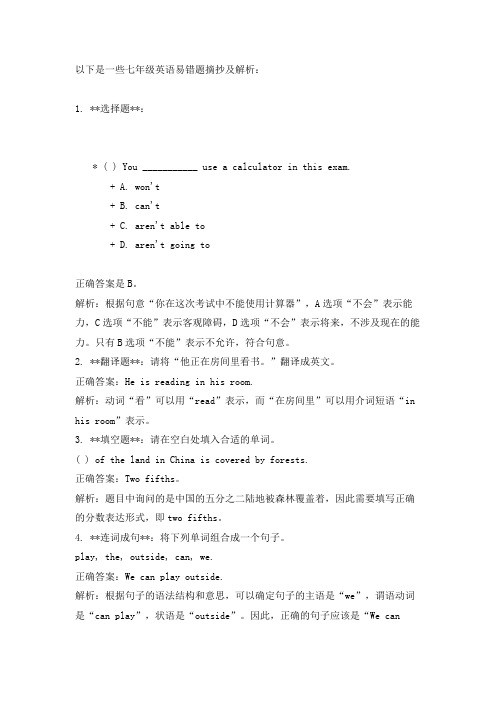
以下是一些七年级英语易错题摘抄及解析:1. **选择题**:* ( ) You ___________ use a calculator in this exam.+ A. won't+ B. can't+ C. aren't able to+ D. aren't going to正确答案是B。
解析:根据句意“你在这次考试中不能使用计算器”,A选项“不会”表示能力,C选项“不能”表示客观障碍,D选项“不会”表示将来,不涉及现在的能力。
只有B选项“不能”表示不允许,符合句意。
2. **翻译题**:请将“他正在房间里看书。
”翻译成英文。
正确答案:He is reading in his room.解析:动词“看”可以用“read”表示,而“在房间里”可以用介词短语“in his room”表示。
3. **填空题**:请在空白处填入合适的单词。
( ) of the land in China is covered by forests.正确答案:Two fifths。
解析:题目中询问的是中国的五分之二陆地被森林覆盖着,因此需要填写正确的分数表达形式,即two fifths。
4. **连词成句**:将下列单词组合成一个句子。
play, the, outside, can, we.正确答案:We can play outside.解析:根据句子的语法结构和意思,可以确定句子的主语是“we”,谓语动词是“can play”,状语是“outside”。
因此,正确的句子应该是“We canplay outside”。
5. **阅读理解**:阅读下面的短文,回答问题。
标题:A Trip to the Zoo今天我和我的家人一起去动物园。
我们看到了很多动物,比如大象、狮子和熊猫。
我非常喜欢熊猫,因为它们非常可爱。
我们还看了海豚表演和猴子表演。
今天真是一个快乐的一天!问题:文章提到了哪些动物?答案:文章提到了大象、狮子和熊猫。
初中英语语法易错题

初中英语语法易错题Company Document number:WTUT-WT88Y-W8BBGB-BWYTT-19998>/易错题一、名词、冠词can I do for you -I'd like two _______.A. box of appleB. boxes of applesC. box of applesD. boxes of apple2. Help yourself to _________.A. some chickensB. a chickenC. some chickenD. any chicken3. ________ it is today!A. What fine weatherB. What a fine weatherC. How a fine weatherD. How fine a weather4. Which is the way to the __________?A. shoe factoryB. shoes factoryC. shoe's factoryD. shoes' factory5. This class ________ now. Miss Gao teaches them.A. are studyingB. is studyingC. be studyingD. studying6. We will have a _________ holiday after the exam.A. two monthB. two-monthC. two month'sD. two-monthstrees are cut down in the forests every year.A. ThousandB. ThousandsC. Thousand ofD. Thousands of8. Our sports meeting will be held ________.A. on 24, Tuesday, AprilB. in April 24, TuesdayC. on Tuesday, April 24D. in April Tuesday 249. _______ people here are very friendly to us.A. TheB. /C. AD. An10. There is no enough ____in the corner to put the table.A. placeB. roomC. floorD. ground答案一:1答案:B.(选择其他3项的同学要注意仔细看题。
牛津译林新版英语七年级上册Unit 1 语法Grammar be动词的一般现在时 重难点易错题精练
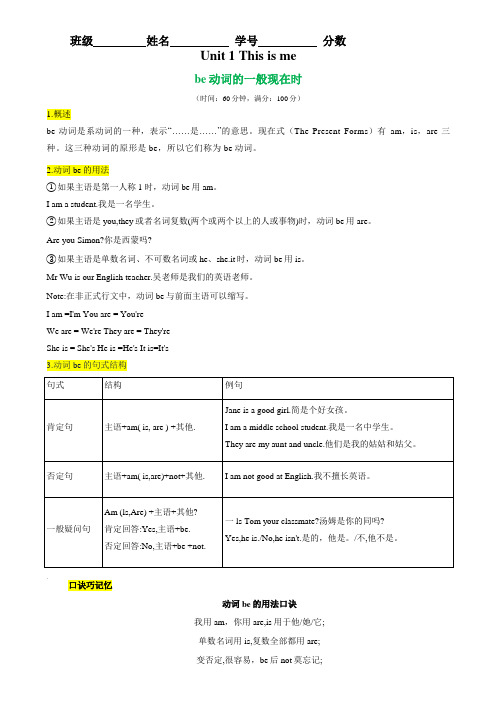
班级姓名学号分数Unit 1 This is mebe动词的一般现在时(时间:60分钟,满分:100分)1.概述be动词是系动词的一种,表示“……是……”的意思。
现在式(The Present Forms)有am,is,are三种。
这三种动词的原形是be,所以它们称为be动词。
2.动词be的用法①如果主语是第一人称1时,动词be用am。
I am a student.我是一名学生。
②如果主语是you,they或者名词复数(两个或两个以上的人或事物)时,动词be用are。
Are you Simon?你是西蒙吗?③如果主语是单数名词、不可数名词或he、she.it时,动词be用is。
Mr Wu is our English teacher.吴老师是我们的英语老师。
Note:在非正式行文中,动词be与前面主语可以缩写。
I am =I'm You are = You'reWe are = We're They are = They'reShe is = She's He is =He's It is=It's3.动词be的句式结构口诀巧记忆动词be的用法口诀我用am,你用are,is用于他/她/它;单数名词用is,复数全部都用are;变否定,很容易,be后not莫忘记;变疑问,be提前,句末问号莫丢弃;否定疑问任你变,句首大写莫迟疑。
一、单项选择(本大题共30小题,每小题2分,共60分)1.(23-24七年级上·江苏宿迁·期中)Jack, Tony and I ________ in the same class.A.am B.is C.are D.be2.(22-23七年级上·江苏扬州·期中)Mary and I _______ in Class 10, Grade 7 in a school near the park.A.be B.am C.is D.are3.(22-23七年级上·江苏南京·期中)— ________ your parents busy every day?—Yes. They don’t have time for me.A.Is B.Are C.Does D.Do4.(22-23七年级上·江苏无锡·期中)—When ________ the school library open?—It’s open from 8 a.m. to 5 p.m.A.is B.are C.does D.do5.(22-23七年级上·江苏南通·期中)Andy ________ late for school today, so he isn’t in the classroom now.A.isn’t B.don’t be C.is D.aren’t6.(22-23七年级上·江苏淮安·期中)—________ Sandy in any club?—Yes, she is a member of the Reading Club.A.Does B.Is C.Do D.Are7.(22-23七年级上·江苏宿迁·期中)—________ your brother good at swimming?—Yes. He wants to be a swimmer like Sun Yang when he grows up.A.Are B.Is C.Do D.Does8.(22-23七年级上·江苏宿迁·期中)There ________ a book and some flowers on the teacher’s desk.A.has B.have C.is D.are9.(22-23七年级上·江苏徐州·期中)—________ your brother usually late for school?—No, never.A.Are B.Do C.Is D.Does10.(21-22七年级上·江苏盐城·期中)Everyone ________ here now. Let’s ________.A.are; starts B.are; to start C.is; start D.is; starting11.(21-22七年级上·江苏盐城·期中)—________ your name Michele?—________.A.Is; Yes, I am B.Is; Yes, it is C.Are; Yes I am D.Are; Yes, it is12.(21-22七年级上·江苏扬州·期中)—________ your mother free this weekend?—No. She has a lot of housework to do.A.Does B.Are C.Do D.Is13.(21-22七年级上·江苏宿迁·期中)Sam with Simon _______ good at English. We often help them_______ their English.A.is; with B.aren’t; for C.aren’t; with D.isn’t; with14.(21-22七年级上·江苏盐城·期中)Millie’s eyes ________ dark brown.A.is B.are C.be D.do15.(21-22七年级上·江苏盐城·期中)The girl with her parents over there ________ Millie.A.be B.am C.is D.are16.(21-22七年级上·江苏镇江·期中)—________ your mother free at the weekend?—No. She always has much work to do.A.Does B.Is C.Do D.Are17.(23-24七年级上·江苏南京·期中)—________ your cousin Sandy good at Maths?—Yes. All of her teachers think she is clever.A.Is B.Do C.Are D.Does18.(23-24七年级上·江苏无锡·期中)—________ your father free on Saturdays?—No, he always has much to do at weekends.A.Do B.Does C.Is D.Are19.(23-24七年级上·江苏无锡·期中)Everyone _________ here. Let’s _________ now.A.is; start B.are; start C.is; to start D.are; to start20.(22-23七年级上·江苏扬州·期中)—________ your cousin a member of Jiangsu Football Club? —Yes. He wants to play in the next World Cup.A.Is B.Do C.Does D.Are21.(21-22七年级上·江苏盐城·阶段练习)—________ everyone here today?—No. Li Hua and Wang Ping ________ here now.A.Is; isn’t B.Is; aren’t C.Are; isn’t D.Are; aren’t22.(20-21七年级上·江苏盐城·期中)—What’s in the reading room? —There________ a desk and thirty chairs in it.A.am B.is C.are D.be23.(20-21七年级上·江苏扬州·阶段练习)—________ your name Millie?—Yes, ________.A.Are, I am B.Is, it is C.Is, I am D.Are, it is24.(20-21七年级上·江苏镇江·期中)Doing morning exercises ________ good for us. It helps us get ready for the day.A.is B.am C.are D.be25.(20-21七年级上·江苏镇江·期中)— What ________ your history teacher like?— He is kind and helpful. I like him very much.A.do B.is C.does D.are26.(20-21七年级上·江苏扬州·期中)Lily and I ________ in Class 2, Grade 7. We are good friends.A.is B.am C.are D.be27.(20-21七年级上·江苏南通·期中)—_________ your father free every weekend?—No, he always has a lot of work to do.A.Does B.Do C.Is D.Are28.(20-21七年级上·江苏南通·阶段练习)Nick’s family ________ a big one. Listen! The family ________ singing Christmas songs.A.is;is B.are; are C.is;are D.are; is29.(20-21七年级上·江苏徐州·期中)Lucy and I_________ friends.A.am B.is C./ D.are30.(18-19七年级上·江苏南通·期中)I ________ late for school because I often get up early.A.don’t be B.am not C.don’t D.am二、单词拼写(本大题共20小题,每小题1分,共20分)31.(23-24七年级上·江苏常州·期中)(be) the children happy in the park today?32.(23-24七年级上·江苏南京·期中)Reading my favourite book (be) interesting.33.(22-23七年级上·江苏泰州·期中)Alice (be not) in the tennis team because she dislikes playing tennis.34.(22-23七年级上·江苏扬州·期中)My cousin, like his father, (not be) fat at all.35.(22-23七年级上·江苏淮安·期中)Just as the old saying goes, it (be) never too old to learn. 36.(22-23七年级上·江苏南京·期中)Tommy (not be) often late for school. He goes to school early. 37.(21-22七年级上·江苏常州·期中)— (be) swimming your favourite sport?—Yes. But I don’t have much time for it.38.(21-22七年级上·江苏无锡·期中)Members in this club (not be) careful. They often leave the club with the lights on.39.(21-22七年级上·江苏无锡·期中)The twins (be) seldom late for school. It’s not easy for them. 40.(21-22七年级上·江苏无锡·期中)Shirley (not be) in the reading room now, right?41.(23-24七年级上·辽宁阜新·期中)Too much meat (be) not good for students.42.(23-24七年级上·辽宁阜新·期中)The police (be) on duty.43.(23-24七年级上·重庆·期中)Linda and I (be) in China now.44.(23-24七年级上·重庆·期中)How (be) your father?45.(23-24七年级上·重庆·期中)Look! Who (be) that girl?46.(23-24七年级上·山东枣庄·期中)Mary and I (be) in the same school.47.(23-24七年级上·安徽合肥·期中)Katherine and Betty (be)from America.48.(23-24七年级上·河北石家庄·期中)My brother and I (be) middle school students and we both learn French.49.(23-24七年级上·山东济南·期中)Here (be)a key, who lost it?50.(23-24七年级上·四川眉山·期中)Li Lei and I (be)good friends and we are from Beijing.三、完成句子(本大题共10小题,每小题2分,共20分)51.(23-24七年级上·江苏无锡·期中)Is your name Simon? (作肯定回答)Yes, .52.(22-23七年级上·江苏无锡·期中)His name is David. (改为一般疑问句,并作否定回答)— his name David?—No, .53.(21-22七年级上·江苏南京·期中)Is Amy tall and slim? (作否定回答)No, .54.(21-22七年级上·江苏无锡·期中)Tom and I are classmates. (改成一般疑问句,并作出肯定回答)and classmates? Yes, .55.(20-21七年级上·江苏徐州·期中)My school is very old.(改为一般疑问句并作否定回答)A: your school very old?B:No, it .56.(23-24七年级上·黑龙江双鸭山·期中)Juice and water are healthy drinks. (改为一般疑问句)juice and water drinks?57.(23-24七年级上·浙江台州·期中)She is my cousin.(改为一般疑问句)your cousin?58.(22-23七年级上·浙江宁波·期中)These are his pencils.(改否定句)These his pencils.59.(21-22七年级上·江西赣州·期中)She is in PEP Middle School. (改为一般疑问句)in PEP Middle School?60.(22-23七年级上·江西赣州·期中)Her watch is on the table. (改为否定句)Her on the table.参考答案:1.C【详解】句意:杰克、托尼和我在同一个班。
(完整版)初中英语易错题及解析

11.That pen _____ 10 yuan .A. spendsB. takesC. costsD. pays 1.答案:C 四个词虽都为花费,但spend 主语必须为人,故剔除,take 后跟双宾语,故也剔除,pay 的意思多为付款,支付,与本语境不符,cost 又可翻译为“值”所以此题选C2.We _____ supper last night.A. haveB. hasC. hadD. are having 2.答案:C “last night last night””表示为过去时,故A 排除,再因为是点动词,故D 排除,时态选择一般过去时,have 过去式为had 故选C3.Tom studies _____ Jack.A. as carefully asB. so carefully asC. as careful asD. so careful as 3.答案:A 固定句型,as......as 中必须加形容词或副词原级,中必须加形容词或副词原级,意为意为意为“和……一样”“和……一样”故选A4.There is _____ in today 4.There is _____ in today’’s newspaper, and you should read it.A. important somethingB. important nothingC. nothing importantD. something important 4.答案:D 当多个形容词修饰名词的时候,当多个形容词修饰名词的时候,观点形容词排在事实形容词之前,观点形容词排在事实形容词之前,观点形容词排在事实形容词之前,故故排除AB ,根据语境”you should read it you should read it””意为你应该读它,说明有一些重要的事情,故选D5.Please remember _____ the door when you leave.A. closeB. to closeC. closingD. Closed 5.答案:B 本题考查动词不定式,首先语法上排除AD ,remember to do sth 意为记得去做某事,remember doing sth 意为记得做过某事,本题译为:请当你离开的时候记得去关门,故选B6.I think collecting model cars will _____ more space.A. take upB. take offC. take inD.take down 6.答案:A 本题考查翻译,本题译为我认为收集模型车将会_____更多的空间take up 意为占用,take off 意为脱下,take in 意为吸收,take down 意为记录,故选A7.They are still playing. They _____ ready for their coming exam now. A. get B. got C. has gotD. should get 7.答案:D get ready for 意为准备做某事,本题翻译为:他们仍然在玩,他们_____现在准备考试,所以根据翻译选D ,应该准备,应该准备8.He _____ four hours _____ the house two days ago.A. Spend; cleaningB. Spend; to cleanC. Spent; cleaningD. spent; to clean 8.答案C “two days ago two days ago””体现时态为过去时,排除AB ,固定句型spent doing sth 故选C9.Look, some boys are playing football, and _____ are playing basketball.A. othersB. otherC. the otherD. another9.答案:B 本题考查几个“另外几个”的辨析,the other 意为特指的另外一个,another 指再一个,other 意为泛指的另外一个,others 为other 的复数形式,指另外几个,本题,some boys 为泛指,又因为为复数be 动词are 故选A10.My grandma often _____ interesting stories.A. saysB. talksC. speaksD. tells10.答案:D say侧重说话的内容,talk侧重双方交谈,speak则主要指说话的动作,tell主指讲述,后常跟双宾语,故选D11.Please _____ me when you get to America.A. write toB. write forC. hear fromD. hear of11.答案:A write意为写,hear意为听,原题翻译为,请写信给我,故排除CD,write to意为写给某人意为写给某人 write for意为为某人写信意为为某人写信 故选A12..He isn’’t from Japan _____ the Republic of Korea.12..He isnA. soB. orC. butD. so12.答案:B so表示所以,or表示或者,but表示但是,and表示和表示和 题目翻译为他不是来自日本或者韩国,故选B13.You should tell her _____ come back home late.A. toB. not toC./D. to not13.答案:B 根据语境“你应该告诉她不要太晚回家”排除AC,动词不定式,动词前加“to”故选B14.--- _____ students are there in the classroom?--- 30.A. How longB. How muchC. How manyD. How often14.答案:C 提问“有多少学生在教室”对数量提问,排除AD,much修饰不可数名词,many修饰可数名词,student为可数名词,故选C15.You can _____ to Shanghai.A. take trainB. by a trainC. by trainD. take a train15.答案:D 根据词组by train ;take a train排除AB,由于选项在题目中做谓语,故选D16.Please remember _____ down your mistakes.A. writeB. to writeC. writingD. wrote16.答案:B 本题考查动词不定式,根据语法排除AD,remember to do sth 意为记得去做某事,remember doing 意为记得做过某事,题目翻译为:请记得写下你的错误,故选B17.I have _____ this bike.A. paid forB. paidC. costD. spent17.答案:A 首先cost主语必须跟物,故排除,paid语法不对,排除,词组,人spent 钱 东西,人 钱paid for 东西,故选A东西 ,人18.It’’s very hot outside. You can wear a _____ coat.18.ItA. BrightB. darkC. heavyD. light18.答案:D 题目翻译:外面非常热,你可以穿上_____大衣,根据语境,应该是light coat 薄大衣,故选D19.Please _____ the application form.A. check outB. call inC. fill outD. hand out19.答案:C 题目翻译为请填写这张申请书,故选C,词组意思为填写,词组意思为填写20.Find old friends and _____ .A. stay in touchB. keep in touchC. in touchD. both A and B20.答案:D stay in touch=keep in touch 意为保持联系,故选D21.I like tennis, _____ I’’m good at it.21.I like tennis, _____ IA. soB. andC. orD. but21.答案:B 本题考查连词,本题并列,我喜欢网球,我也很擅长它,故选B 22.--- Must I tidy up my room?--- No, you _____ . A. mustn A. mustn’’t B. needn B. needn’’t C. can C. can’’t D. must22.答案:B 本题考查情态动词,题为我必须整理我的房间么,不你不需要,故选B23.Camping is one of _____ .A. more interesting activitiesB. interesting activityC. the most interesting activityD. the most interesting activities 23.答案:D 露营是最有趣的事情之一,用最高级,排除AB ,由于是之一,说明有很多有趣的事情,故用复数形式,排除C ,选择D24.It is a good way _____ about American culture. A. to learn B. learn C. learningD. learnt 24.答案:A 固定词组,way to do sth 用某种方法或技巧做某事用某种方法或技巧做某事25.John _____ maths and he often helps Kate with her maths.A. does well inB. are good atC. is weak atD. do well in 25.答案:A 题目翻译为,约翰的数学很优秀,他经常帮助凯特学习数学,先排除C ,be good at 意为擅长做某事,do well in 意为在某方面做的好,这里应为做的好,而不是指约翰擅长数学,故排除B ,often 提示为一般现在时动词应改为三单形式故选A26.The English course _____ 1000 yuan a month.A. spendsB. takesC. paysD. costs 26.答案:D spend 前主语必须为人,故排除A ,take 后常跟双宾语,故排除B ,根据翻译,英语课程费用1000元一月,pay 意为付钱买某物,cost 意为费用,故D 为最佳选项为最佳选项27.--- _____ does the course last?--- It lasts for four weeks. A. When B. How soon C. How long D. How often 27.答案:C 问你在这门课上上多长时间了,选择C ,多长时间,多长时间28.She can hardly hear anything in such a noisy restaurant, _____ ?A. can sheB. can B. can’’t sheC. can itD. can D. can’’t it 28.答案:A 本题考查反义疑问句,她几乎在嘈杂的餐厅里听不见任何声音,主语是否定句,后面要用肯定句型,故排除BD ,主语是she ,故选择A29.Jim asked me _____ .A. what was the matterB. what the matter areC. what is the matterD. what the matter is 29.答案:A 本题考查宾语从句,what 代指主语,宾语从句永远为陈述语序,所以后跟动词,故排除BD ,asked 表明主语为过去时,从句也要变为过去时,故选A30.I had a bad cold. The doctor asked me _____ in bed for a good rest.A. stayingB. staysC. stayD. to stay 30.答案:D 固定词组ask sb to do sth 意为让某人做某事意为让某人做某事31.Mr Wang suggested _____ a class meeting after school.A. to haveB. haveC. havingD. to stay31.答案:C 固定词组suggest doing sth 意为建议某人做某事意为建议某人做某事 32.I like the jacket very much, but it is _____ dear.A. much tooB. too muchC. very muchD. too many 32.答案:A 我非常喜欢那个夹克,但是亲爱的,它太贵了,语法上排除C ,修饰不可数名词排除D ,much too 后接形容词后接形容词too much 后接名词,故选择A 33.--- Excuse me, how can I get to the bus stop?--- Please walk _____ this street, then turn left, and you will find it. A. along B. over C. aloneD. with 33.答案:A 沿着这条街走,along this street34.Why don 34.Why don’’t we _____ the answers again?A. to checkB. checkC. checkingD. checked34.答案:B 陈述事实,用一般现在时,故选B35.I believe _____ my dream will come true one day.A. whatB. whichC. whoD. that35.答案:D 本题考查宾语从句,从句无缺失部分,故选that 无实意无实意36.He knows _____ he can finish the task by himself.A. howB. whatC. thatD. Who 36.答案:C 本题考查宾语从句,从句无缺失部分,故选that 无实意无实意37.In the park, we can hear the birds _____ .A. singingB. songC. to singD. sang 37.答案:A 固定词组:hear sb doing sth 听到某人正在做某事38.I think _____ you can improve your EnglishA. whichB. whatC. howD. / 38.答案:D 简单句中无需加连词39.It’It’s _____ dark _____ we cans _____ dark _____ we can s _____ dark _____ we can’’t see anything. A. such a; that B. so; that C. such a; thatD. so a; that 39.答案:B so 后直接加形容词后直接加形容词40.Kate is _____ kind girl _____ we all like her. A. so; that B. so a; that C. such a; thatD. such; that 40.答案:C such 后加冠词,再后加名词,故选C41.We don 41.We don’’t allow people _____ in the cinema.A. smokeB. smokedC. smokingD. to smoke 41.答案:D 固定词组:allow sb to do sth 意为允许某人做某事意为允许某人做某事42.Tony _____ about Beihai Park so far.A. didn A. didn’’t hearB. doesn B. doesn’’t hearC. hasn C. hasn’’t heardD. has hear 42.答案:C 本题翻译为,托尼还没有听说过北海公园,到目前为止没听说过,不代表以后没听说过,所以用现在完成时,故选C43.The teacher told us _____ alone by the lake.A. to not campB. not campC. not to campD. not camping 43.答案:C 固定词组,tell sb do sth 故排除BD ,若是否定句,否定词要加在不定式之前,故选C44.The boss did not tell me _____ to do next.A. whatB. whichC. whenD. That 44.答案:A 宾语从句,老板没有告诉我下一步做什么,所以连词选择what45.Some people are taking photos and _____ are enjoying the beautiful views in the parkA. othersB. the otherC. anotherD. other 45.答案:A 本题考查几个“另外几个”的辨析,the other 意为特指的另外一个,another 指再一个,other 意为泛指的另外一个,others 为other 的复数形式,指另外几个,另外一些人再踢足球,指的是泛指的复数,故选A46.My sister likes hiking _____ I enjoy staying at homeA. soB. forC. whileD. or 46.答案:C 本题翻译为:我妹妹喜欢徒步旅行,而我喜欢待在家里,连词表转折,故选while 而47.My parents promise _____ me to Hong Kong this summer holiday.A. tookB. takeC. takingD. to take 47.答案:D 首先出现动词promise 后接动词必须有不定式,故排除AB ,promise doing 和promise to do 都表示承诺做某事,但前者代表正在做,后者代表还未做,本题翻译:我父母承诺这个暑假带我去香港,还没有去,故选D48.I 48.I’’m sure _____ he can overcome the difficulties.A. thatB. howC. whereD. if 48.答案:A 考查宾语从句,从句无缺失,故选that 占位占位49.Jack knows _____ his father won 49.Jack knows _____ his father won’’t let him camp alone.A. whenB. whereC. /D. what 49.答案:C 本句为简单句,无须连词,故选C50.---Why don 50.---Why don’’t we _____ for a swim?---Good idea. A. to go B. go C. goingD. goes 50.答案:D 本题翻译:我们为什么不去游泳呢?本题翻译:我们为什么不去游泳呢?用一般现在时,故选B 51.I am a teacher _____ she is doctor.A. orB. soC. aboutD. while 51.答案:D 本题翻译为我是个教师而她是个医生,连词表转折,故选while 而 52.This question is _____ hard for me _____ answer.A. so; thatB. such; thatC. too; toD. very; that 52.答案:C too...to...意为太难……以至于……本题翻译为这道题对我来说太困难了53.I made the baby _____ .A. cryB. cryingC. criedD. to cry 53.答案:A 固定句型,made sb do sth 让某人做某事让某人做某事54.I have made _____ others since I came to this school.A. friends withB. a friend withC. friends toD. a friend to 54.答案:A 固定句型,made friends with 和某人交朋友和某人交朋友55.I don 55.I don’’t know _____ Tim is asleep. A. what B. who C. howD. If 55.答案:D 考查宾语从句连词,题目翻译为我不知道Tim 睡着没有,所以选if56.I don 56.I don’’t know _____ he will come tomorrow. _____ he comes, I t know _____ he will come tomorrow. _____ he comes, I’’ll tell you.A. if; WhetherB. whether; WhetherC. if; ThatD. if; If 56.答案:D 题目翻译为我不知道他明天是否来,如果他来了,我将告诉你,第一个if 为宾语从句的连词,表是否,第二个if 译为如果,故选D57.Look, the baby is smiling _____ you.A. atB. withC. forD. of57.答案:A 考查介词,smile at sb 译为对…微笑(smile to sb :给…一个微笑,smile on sb :上级对下级的微笑):上级对下级的微笑)58. He refuses _____ anything.A. explainB. ExplainingC. to explainD. explains58.答案:C 固定词组:refuse to do sth 译为拒绝做某事译为拒绝做某事59.I often hear my mother _____ .A. songB. to singC. singsD. Singing 59.答案:D 考查动词不定式,语法上排除ABC ,故本题选D (hear sb do sth 听到某人做了某事到某人做了某事 hear sb doing sth 听到某人正在做某事)听到某人正在做某事)60._____ doesn 60._____ doesn’’t matter _____ Mr Smith will come or not.A. That; whetherB. It; whetherC. That; ifD. It; if 60.答案:B 宾语从句,我不知道史密斯先生是否来,有whether 就不选if 故排除CD ,主语为形式主语,代指“Mr Smith will come or not ”故选it61.Do you know what _____ the little boy?A. happened has toB. happened withC. has happened toD. have happened 61.答案:C 翻译为你知道那个小男孩么?宾语从句主语做疑问词,故排除AB ,本题应用过去时,故选C62.She _____ the work very dull (无聊的).A. found outB. looked forC. foundD. discovered62.答案:C look for 译为寻找 discover 译为碰见 故都排除,found out ;found 都译为发觉,但前者更强调过程而后者更强调结果,故选C63.Nobody knows _____ to visit our school.A. when will he comeB. when does he comeC. when he would comeC. when he comes 63.答案:D 选项为宾语从句,必须为陈述语序,故AB 排除,本题翻译为没人知道他什么时候参观我们学校,还没有参观,故不能选过去时,C 排除,选D64.Please tell us _____ to the science museum.A. how can we reachB. how we can reachC. how can we getD. how we can get 64答案:D 宾语从句永远为陈述语序,排除AC ,reach 为及物动词,故排除选D65.Bob didn ’t go to bed _____ he finished his work.A. untilB. sinceC. whileD. when65.答案:A 题目翻译为Bob 没有睡觉直到他完成了工作,故选until 直到66.--- What about _____ this mistake again.--- Good idea. A. making B. to make C. goingD. went 66.答案:C 介词之后只加doing 故选C67.Our school football team will play _____ his school football team tomorrow.A. withB. inC. onD. against 67.答案:D against 译为反对,对抗,本题译为我校足球队明天将对抗他校足球队68.Could you tell me _____ she is looking for?A. thatB. whoseC. whoD. which68.答案:C 宾语从句,你能告诉我她是谁么?69.I don’ know if my uncle _____ . If he _____ , I will be very happy.A. comes; will comeB. will come; will comeC. comes; comesD. will come; comes69.答案:D 考查时态,第一空,我不知道我叔叔是否来,还没有来,故选择将来时,排除AC,第二空,如果他来了,这里说的是已经来了,故用一般现在时,选D70.He asked me _____ we could go to Beijing to watch the game by plane.A. thatB. ifC. howD. what70.答案:B 题目翻译为他问我外面是否乘飞机去北京看比赛,故选if 是否71.We want to know _____ .A. what is his nameB. what his nameC. what his name isD. that his name is71.答案:D 宾语从句永远陈述语序,排除A,从句缺乏宾语,排除D,B项缺乏代词,排除,故选D。
初中英语语法实用易错题
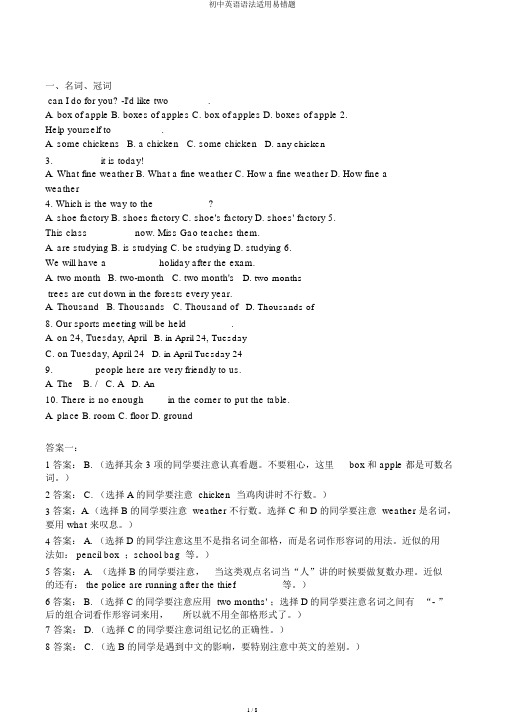
一、名词、冠词can I do for you? -I'd like two _______.A. box of appleB. boxes of applesC. box of applesD. boxes of apple 2.Help yourself to _________.A. some chickensB. a chickenC. some chickenD. any chicken3. ________ it is today!A. What fine weatherB. What a fine weatherC. How a fine weatherD. How fine aweather4. Which is the way to the __________?A. shoe factoryB. shoes factoryC. shoe's factoryD. shoes' factory 5.This class ________ now. Miss Gao teaches them.A. are studyingB. is studyingC. be studyingD. studying 6.We will have a _________ holiday after the exam.A. two monthB. two-monthC. two month'sD. two-monthstrees are cut down in the forests every year.A. ThousandB. ThousandsC. Thousand ofD. Thousands of8. Our sports meeting will be held ________.A. on 24, Tuesday, AprilB. in April 24, TuesdayC. on Tuesday, April 24D. in April Tuesday 249. _______ people here are very friendly to us.A. TheB. /C. AD. An10.There is no enough ____in the corner to put the table.A. placeB. roomC. floorD. ground答案一:1答案: B. (选择其余 3 项的同学要注意认真看题。
《易错题》七年级下英语常用语法知识——疑问句经典复习题(培优专题)
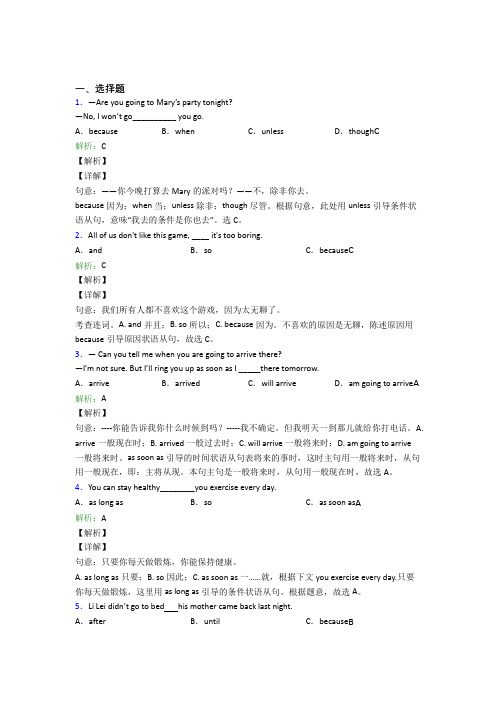
一、选择题1.—Are you going to Mary’s party tonight?—No, I won’t go__________ you go.A.because B.when C.unless D.though C解析:C【解析】【详解】句意:——你今晚打算去Mary的派对吗?——不,除非你去。
because 因为;when 当;unless 除非;though 尽管。
根据句意,此处用unless引导条件状语从句,意味“我去的条件是你也去”。
选C。
2.All of us don't like this game, ____ it's too boring.A.and B.so C.because C解析:C【解析】【详解】句意:我们所有人都不喜欢这个游戏,因为太无聊了。
考查连词。
A. and并且;B. so所以;C. because因为。
不喜欢的原因是无聊,陈述原因用because引导原因状语从句,故选C。
3.— Can you tell me when you are going to arrive there?—I’m not sure. But I’ll ring you up as soon as I _____there tomorrow.A.arrive B.arrived C.will arrive D.am going to arrive A 解析:A【解析】句意:----你能告诉我你什么时候到吗?-----我不确定。
但我明天一到那儿就给你打电话。
A. arrive一般现在时;B. arrived一般过去时;C. will arrive一般将来时;D. am going to arrive一般将来时。
as soon as引导的时间状语从句表将来的事时,这时主句用一般将来时,从句用一般现在,即:主将从现。
本句主句是一般将来时,从句用一般现在时,故选A。
【英】七年级英语语法易错题集
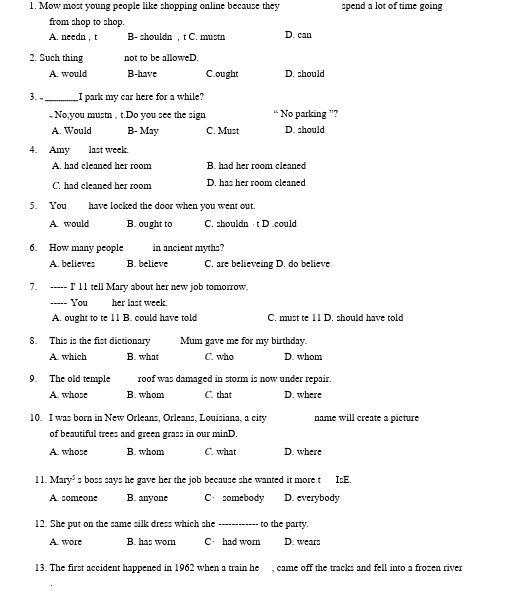
1. Mow most young people like shopping online because they ____________ spend a lot of time goingfrom shop to shop.4. Amy ___ last week.A. had cleaned her room C. had cleaned her room5. You ___ have locked the door when you went out.A. wouldB. ought toC. shouldn ,t D .could6. How many people _____ i n ancient myths?A. believesB. believeC. are believeingD. do believe7. ----- I' 11 tell Mary about her new job tomorrow.----- You ____ h er last week. A. ought to te 11 B. could have toldC. must te 11D. should have told8. This is the fist dictionary _____ Mum gave me for my birthday.A. whichB. whatC. whoD. whom9. The old temple _____ r oof was damaged in storm is now under repair.A. whoseB. whomC. thatD. where10. I was born in New Orleans, Orleans, Louisiana, a city ________ name will create a pictureof beautiful trees and green grass in our minD. A. whoseB. whomC. whatD. where11. Mary 5s boss says he gave her the job because she wanted it more t __ IsE. A. someoneB. anyoneC ・ somebodyD. everybody12. She put on the same silk dress which she ------------ to the party. A. woreB. has wornC ・ had wornD. wears13. The first accident happened in 1962 when a train he__ , came off the tracks and fell into a frozen river・A. needn ,t B- shouldn ,t C. mustnD. can2. Such thing__ not to be alloweD.A. wouldB-haveC.oughtD. should3. 一 _________________I park my car here for a while?一No,you mustn ,t.Do you see the signA. WouldB- MayC. Must“ No parking ”? D. shouldB. had her room cleaned D. has her room cleanedA. was travelling B・ travelling C・ had travelied D. travelied14.My fii'end recommended ---------- the film.A. to seeB. have seen C・ seeing D. see15.1----- my homework, so I guess I can join you.16.Writing stories and articles _______ what I enjoyed most.A. isB. areC. wasD. we re17.一Mr. wang, I have some difficulty ________ the articlE.—Remember ______ it three or four times at least.A. to understand; reading B・ understanding; readingC. understanding; to readD. to understand; to read18.1' m sorry ____ told you about the accident at the timE・A. to not have B・ not to have C. not having D・ to have not19.How can you keep the machine ________ when you are away?A. runB. to run C・ running D. being run20.How kind you are !You always do what you can ________ others・A. helpB. to helpC. helpingD. helps21 ・ --- The story is so amazing! ------------- B ut I am afraid it won ' t be liked by .A. everybody B・ somebody C. anybody D・ nobody22.Rose's fathej:________ to Paris last month. He __________ there three times.A. went, had goneB. has gone, has beenC. went, has beenD. has been, has gone23.Tom enjoys the journey in the winter ______ the storms can be quite exciting.A. whichB. whoC. whenD. where24.------ ----- I do the cleaning now?A. don 7 t finish B- didn ,t finish C. haven ' t finish D. won't finishNo,you ___ • You it this afternoon.A. Need ; don't have to ; mustC・ Must ; don't have to ; must25.Can you tell me in the future _____A. how life will be likeC. what life will be like26.1can ' t find my pen. Wh ______A. takesB. takeB.Must ; needn't ; mayD. Should ; mustn*t ; needn't 9■B.how will life be likeD. what will life be likeit?C.took D- taken27.He has -------- been to Chongqing, has he?A. alreadyB. neverC. everD. stiU28.Have you met Mr Li ----------- ?29. ------- ----- you ____ your homework?----- Y es, fit a moment ago.A. Did; do; finishedB. Have; done; finished C ・ Have; done; have finished30. The school ______ was built in 1956 is very big ・A. whichB. whereC. thatD. both A and C31. Is this factory _____ he worked ten years ago?A. thatB. whereC ・ whatD ・ the one32. — Why was he late for school yesterday?—He overslept.By the time he got to the bus stop,the bus _________ akeady __________ A. was; leaving B. has; leftC ・ would;leaveD. had; left33 ____ you ____ basketball at 4:00 yesterday afternoon?A. Did;playB. Did;playing fC. Ai^e;playingD. Were ;playing 34. Evervoneto draw pictures ■A. beginB. beginsC ・ beginningD.began35. Cheesefrom milk.A. is madeB. was madeC. are madeD. we re made36.1 didn ' t have enough timenewspaper today.A. have readB. readingC. readD. to read37. Today Chinese by more and more people around the worlD. A. speakB.spokeC. is speakingD. is spoken38. We can 5t use the bridge now because it _____A. has been re :paired B ・ isrepairingC. is repaked D ・ is being repaired 39. Our clavichord is kept in the living room.That 's where it. weA. keptB. have keptC. are keepingD. keep40. About 500 cars ______ in the factory next month.A. we re producedB. will produceC. has been producedD. will be produced41 ・ We are very glad to know that a great sports meeting ------------ in Guiyang this September.A. will holdB. will be heldC. will be holdD. be held42・ How long ------- he ------- ?A. justB ・ agoC. beforeD. a moment agoD ・ will; do; finishA. had ; die B・ has ; died C. has ; death D. has ; been dead43.The old must be looked after well and ------------- politely・A. spoken B・ speak to C・ speak D. spoken to44.— Aunt Chen,who is the pretty girl in red in the picture?—It' s my daughter.The pictunlO years ago.A. tookB. is taken C・ has taken D. was taken45. _______ a new library _________ in our school last year?A. Is, builtB. Was,builtC. Does, builtD. Did,built46.— Have you finished your homework?47. The old must be looked after well and _______ politely-49. Tony said that ____ singing when the telephone rang.A. he had beenB. he isC. he wasD. he has been50. The letter ____ t hree days ago and it _______ y esterday.A ・had post ; had arrivedB ・ was posted ; anived C. posted ; arrivedD. had been posted ; was arrived51. A talk on Chinese history ______ in the school hall next week.A .is givenB ・ will be givenC. has been givenD. gives52. We ___ the machine _____ just now.A. had ; fixB. have ; fixedC. got ; fixedD. get ; fixed58. Do you know where _____ now?A. he livesB. does he liveC. he livedD. did he live59・ Could you tell me ____ t he nearest hospital is?A. whatB. whichC. howD. whereE. whyA. giveB- am given C. will give D. am givingA•spoken B. speak to C.speak D. spoken to 48.… _____ did he feel?…Very nervous.A. WhatB- How much C. HowD. WhichE. When53. Tom:” How will be the weather tomorrow?=> Tom askedtomorrowA. how would the weather be like C ・ how the weather would beB. how will the weather be D. how the weather will be54. Jack: n Why do you look wo med?A .Why I did lookB ・ why did I look=> Jack asked me _____ worrieD. C. why you looked D. why I looked55. My friend asked me how much A.do I spend on my car C. I spent on my car 56. Could you tell me _____ ?A. where do you live C. who were you waiting for 57.1 don ' t know ____ the day afterA. when does he come C. if he comesB. did I spend on my car D. had I spent in my carB. who you are waiting forD. where you live intomonow.B. how will he come D. whether he will come60. Do you know ____ ?A. whose book is thisB. whose book this isC. this book is whoseD. who ' s book this is答案:1-10:ACBBB AD AAA 11-20:BCACC CCBCB 21-30:ACCBC CBCBA31-40:BDDBA DDDDD 41-50:CDDDB BDCCB 51-60:BCCDC BDADB。
期中必考重点易错语法综合练习100题-2024-2025学年七年级英语上册单元重难点易错题精练(人教
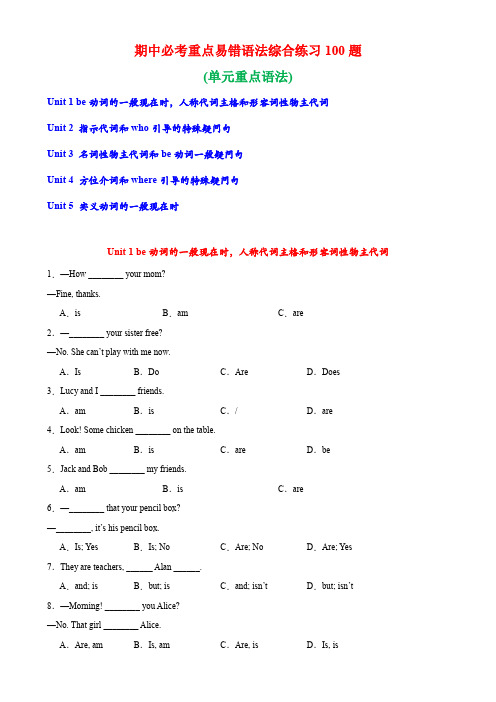
A.Is; YesB.Is; NoC.Are; NoD.Are; Yes
7.They are teachers, ______ Alan ______.
A.and; isB.but; isC.and; isn’tD.but; isn’t
8.—Morning! ________ you Alice?
—________. They are Sally’s.
A.Yes, they areB.No, these aren’tC.No, they aren’t
28.—Are ________ your brothers?
—No, they ________ my friends.
A.those; areB.these; isC.this; areD.that; is
A.Gina; herB.Gina’s; herC.Gina; hersD.Gina’s; hers
56.________ English books are on the desk, and ________ are in the bookcase.
A.Their; oursB.Ours; theirC.Yours; our
—No, they are ________.
A.your; mineB.his; herC.my; yourD.her; his
53.—Is this your schoolbag, Bob?
—Yes, it’s ________. And the yellow schoolbag is ________.
A.myB.hisC.herD.your
19.This is Mr. Green and ________ given name is John.
- 1、下载文档前请自行甄别文档内容的完整性,平台不提供额外的编辑、内容补充、找答案等附加服务。
- 2、"仅部分预览"的文档,不可在线预览部分如存在完整性等问题,可反馈申请退款(可完整预览的文档不适用该条件!)。
- 3、如文档侵犯您的权益,请联系客服反馈,我们会尽快为您处理(人工客服工作时间:9:00-18:30)。
初一英语语法易错题
一、名词类
1. 这些女老师们在干什么?
误:What are the woman teachers doing?
正:What are the women teachers doing?
析:在英语中,当一名词作定语修饰另一名词(单或复数形式)时,作定语的名词一般要用其单数形式;但当man,woman作定语修饰可数名词复数形式时,要用其复数形式men, women。
2. 房间里有多少人?
误:How many peoples are there in the room?
正:How many people are there in the room?
析:people作“人、人们”解时,是个集合名词,其单复数同形。
3. 我想为我儿子买两瓶牛奶。
误:I want to buy two bottle of milk for my son.
正:I want to buy two bottles of milk for my son.
析:表示不可数名词的数量时,常用“a / an或数词+表量的可数名词+of+不可数名词”这一结构,其中当数词大于1时,表量的可数名词要用其复数形式。
二、动词类
4. 你妹妹通常什么时候去上学?
误:What time does your sister usually goes to school?
正:What time does your sister usually go to school?
析:借助助动词do(或does)构成疑问句或否定句时,句中的谓语动词用其原形。
5. 琳达晚上经常做作业,但今晚她在看电视。
误:Linda often do her homework in the evening, but this evening she watching TV.
正:Linda often does her homework in the evening, but this evening she is watching TV.
析:在初一英语学习阶段,我们接触到了两种主要时态:一般现在时和现在进行时。
一般现在时表示经常的或习惯性的动作,常和often,usually,sometimes 等时间状语连用。
在一般现在时的句子中,若主语是第三人称单数,谓语动词要用其第三人称单数形式。
现在进行时表示现阶段正在进行或发生的动作,现在进行时由be (am / is / are) + ving形式构成。
6. 这双鞋是红色的。
误:This pair of shoes are red.
正:This pair of shoes is red.
析:在shoes, trousers, gloves, glasses等表示成双成对的衣物或工具名词前用pair(表计量)修饰时,谓语动词的形式由pair的单复数形式来决定。
三、代词类
7. 这张票是她的,不是我的。
误:This is hers ticket. It's not my.
正:This is her ticket. It's not mine.
析:物主代词有形容词性物主代词和名词性物主代词之分。
形容词性物主代词之后一定要接名词,而名词性物主代词之后不需接任何词。
8. 吴老师教我们英语。
误:Miss Wu teaches our English.
正:Miss Wu teaches us English.
析:teach sb. sth.中的sb.作teach的宾语,因此当sb.为人称代词时要用其宾格形式。
四、介词类
9. 你能找到这个问题的答案吗?
误:Can you find the answer of this question?
正:Can you find the answer to this question?
析:英语中用“the answer to…”表示“……的答案”。
类似结构还有the key to the door, the way to the zoo等。
10. 格林先生星期六上午来这里。
误:Mr Green will come here in Sunday evening.
正:Mr Green will come here on Sunday evening.
析:表示在上午、下午等时,介词要用in;而表示在具体的某天上午、下午时,介词要用on。
11. 那个穿着红裙子的小女孩是我们老师的女儿。
误:That little girl on a red skirt is our teacher's daughter.
正:That little girl in a red skirt is our teacher's daughter.
析:用介词表示“穿戴衣物”时,只能用in,其他介词没有此用法。
五、副词类
12. 莉莉,你为什么不回家呢?
误:Lily, why don't you go to home?
正:Lily, why don't you go home?
析:come, go等后接here, there, home等地点副词时,地点副词前不加to。
六、连词类
13. 我喜欢语文和英语,但我不喜欢体育和历史。
误:I like Chinese and English, but I don't like P.E. and history.
正:I like Chinese and English, but I don't like P.E. or history.
析:在肯定句中并列成分之间用and来连接;而在否定句中,并列成分之间的连接需用or。
七、冠词类
14. 乘飞机去北京花了史密斯一家人一个小时。
误:It takes Smiths a hour to go to Beijing by a plane.
正:It takes the Smiths an hour to go to Beijing by plane.
析:1. 表示“……一家人”用结构“the + 姓氏复数”;
2. our 一词的第一个字母不发音,它是以元音音素开头的,所以“一小时”要用an hour;
3. 用介词by表示“乘坐”某种交通工具时,交通工具名词前不加任何冠词。
八、句法类
15. ――你不是学生吗?――不,我是学生。
误:--Aren't you a student? --No, I am.
正:--Aren't you a student? --Yes, I am.
析:对否定疑问句的回答是用Yes还是用No,这取决于实际情况:如果事实是肯定的,就用Yes表“不”;如果事实是否定的,就用No表“是的”。
enjoy doing sth 享受或喜欢做某事
be busy doing sth 忙于做某事
It`s+adj +to do sth . 做......是.....的
try doing 试着做某事
ask sb.to do 叫某人做某事
forget doing 忘记已经做过的事
forget to do 忘记要做某事
remember to do 记得要做某事(还没做过)
remember doing 记得做过的事
let sb do 让某人做某事
make sb do 使某人做某事
like doing sth 喜欢做某事(习惯上的)
start to do sth 开始做某事
start doing sth 开始做某事
finish doing sth 完成....
(一般现在时态)be doing 正在做...
would like to do (表示意愿)
spend......(in) doing sth 花费....做...
look forward to doing sth 期待做某事
want to do sth 想要做某事
decide to do sth 决定...
It takes sb sometime to do sth 花费某人多少时间做... be going to do sth/will do(一般将来时态)将要做某事Thank for doing sth 感谢做某事。
